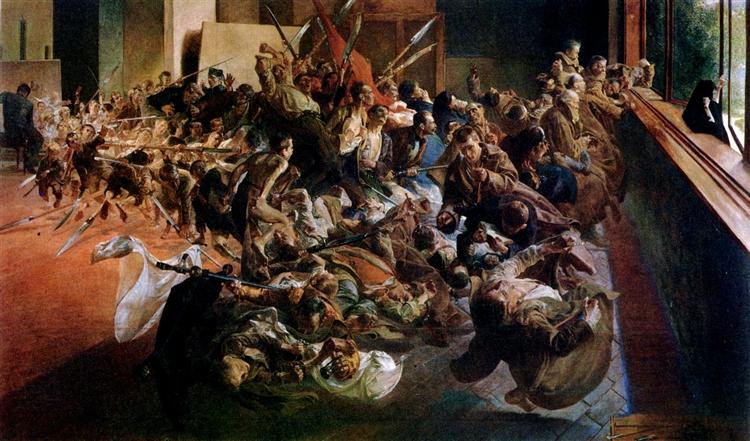Description
Jacek Malczewski's melancholy, painted in 1894, is erected as a powerful emblem of emotional introspection and the complexity of human experience. This painting It belongs to the symbolist movement, characteristic of Malczewski's work, who was a prominent representative of Polish art at the end of the 19th and early twentieth century. In this painting, the artist not only channels his personal concerns, but also reflects the Zeitgeist of an era that sought new forms of expression beyond immediate reality.
At first glance, what impacts the spectator is the deep color palette in turned off that dominate the composition. The blue and brown are combined to create a melancholic environment, suitable for the subject that is presented. The general atmosphere is gloomy and contemplative, transporting the viewer to an emotional state that aligns with the title of the work. This chromatic choice is not accidental; Color is used as a language in itself, allowing Malczewski to explore sadness and nostalgia, universal feelings that resonate in all of us.
In the compositional plane, melancholy stands out for its attention to symbolism. In the center of the painting, there is the figure of a woman, represented with an almost ethereal serenity. His lost look, which seems to cross the canvas, invites reflection and silence. It can be interpreted that she is the personification of the melancholy, a state of the being that manifests itself in her enigmatic position and her introspective expression. The female figure, in this context, can symbolize the search for meaning amid emotional desolation. Around it, various elements help build a complex visual story that evokes internal struggle with emotions and memories.
The treatment of light in this work deserves special attention. Malczewski uses the light subtle, achieving an effect that highlights the central figure and, at the same time, reinforces the atmosphere of sadness. Clear management reinforces drama, creating contrasts that guide the view towards the heart of the work. The thorough details in the background, which present a gloomy and almost oppressive nature, contrast with the glowing figure of women, suggesting a delicate balance between hope and hopelessness.
In terms of style, "melancholy" shares affinities with other works of symbolism, where personal expression and the use of subjective iconography prevail over the clear and defined narrative. Malczewski, influenced by French symbolism and the rich tradition of Polish art, manages to merge these styles in a work that is both personal and universal. Melancholy becomes here a central theme, addressing not only individual sadness, but also a broader sense of yearning and loss.
It is important to place the creation of Malczewski in the cultural context of Poland, which at that time was in search of its own artistic identity and a voice that reflected its national sufferings and hopes. Melancholy is not only a portrait of an emotional experience; You can also read as a comment on the human condition in a world in transformation.
In summary, Jacek Malczewski's melancholy painting is a deep exercise of introspection that, through its rich color and care symbolism, offers a penetrating look at human sadness. The combination of its central figure, which personifies melancholy, and the atmosphere created by color and light, invites spectators to an emotional journey that transcends time and space, reaffirming the relevance of art in the exploration of the condition of the condition human As we contemplate this work, we are driven to reflect on our own experiences of longing and loss, and we find in melancholy a common thread that unites humanity.
KUADROS ©, a famous paint on your wall.
Hand-made oil painting reproductions, with the quality of professional artists and the distinctive seal of KUADROS ©.
Art reproduction service with satisfaction guarantee. If you are not completely satisfied with the replica of your painting, we refund your money 100%.

